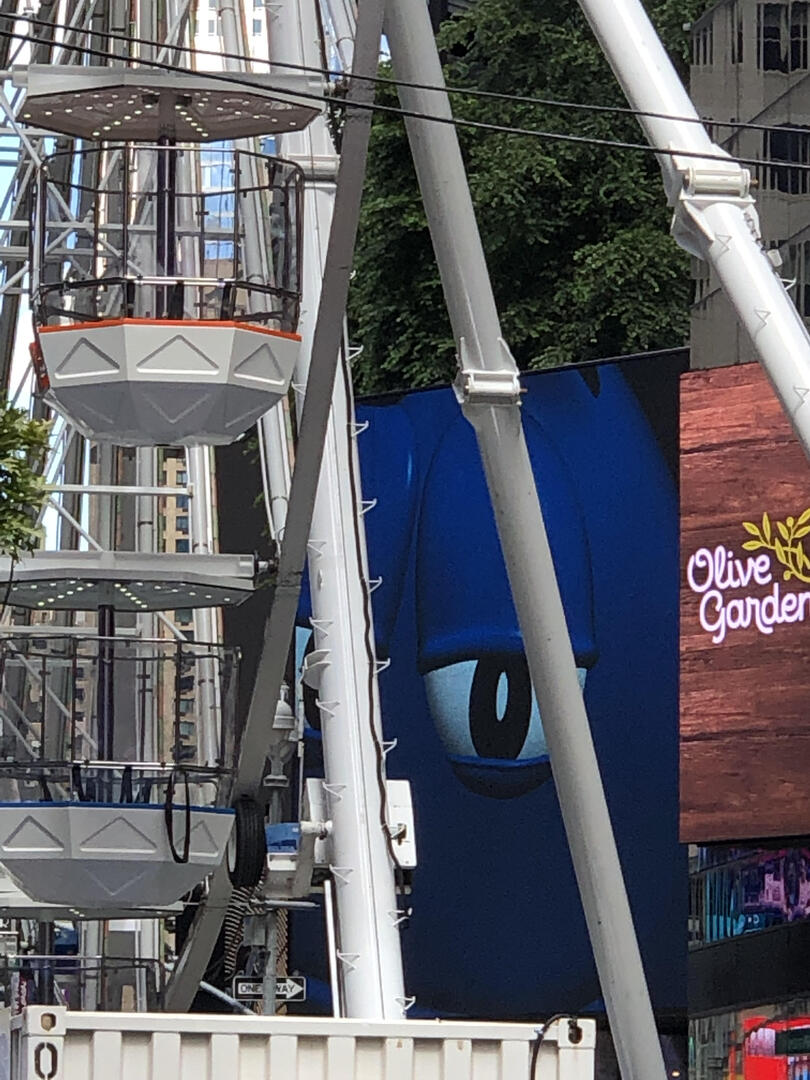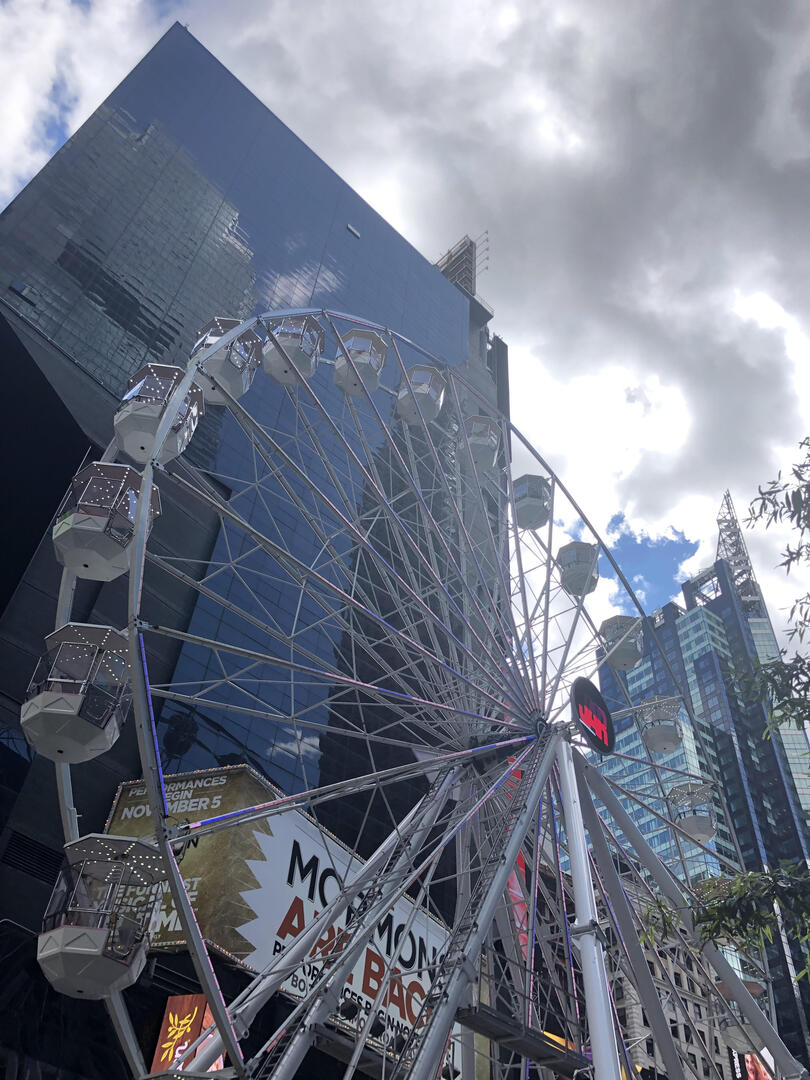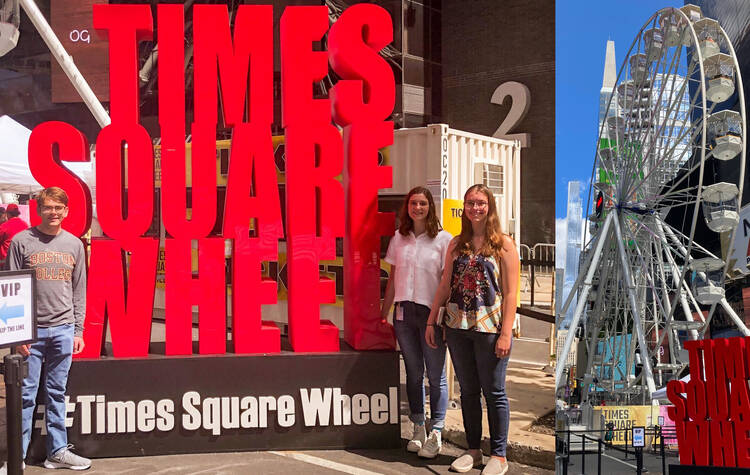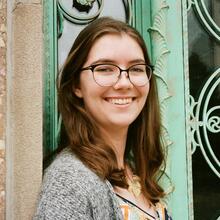From Aug. 25 to Sept. 12 in New York City, a gigantic Ferris wheel occupied the middle of Times Square. Located in the middle of Broadway between West 47th and 48th streets, the Times Square Wheel stood 110 feet high and offered riders a 12-minute trip for $15 for kids and $20 for adults ($35 if one wanted to “skip the line”) between noon and midnight each day. Those who could offer proof that they had received a Covid-19 vaccine between Aug. 1 and Sept. 12 could ride for free.
The “pop-up” project was a joint collaboration between a Brooklyn production company, AMPM Entertainment Concepts, and the Times Square Alliance, a local business consortium. New York City Mayor Bill de Blasio called the Times Square Wheel “a symbol of recovery” for New York, and an attraction that “is going to add even more energy and excitement to a place that's already synonymous with energy and excitement.”
Three of America’s newest employees, O’Hare fellows Keara Hanlon, Doug Girardot and Sarah Vincent, made the short trip from America’s offices to experience the Times Square Wheel.
Three of America’s newest employees, Joseph A. O’Hare Fellows Keara Hanlon, Doug Girardot and Sarah Vincent, made the short trip from America’s offices to experience the Times Square Wheel on Friday, Sept. 3. Their reflections—and some images of the day—are below.
Keara Hanlon
I will admit that my immediate reaction upon hearing about this attraction was sardonic laughter. “Free rides to people who get vaccinated during the wheel’s run.” If heaps of moral and logical reasoning (not to mention intensive care units overflowing with the unvaccinated) had not convinced one to get the jab, would a free ride on this monstrosity really do the trick? And what would it say about humanity if that kind of marketing did work? The circumstances of my young life have made me jaded before my time, I suppose.
Arriving at Times Square is an experience in sensory overload. Distracted by the many screens, I am caught in a tourist trap by a man in a brown robe. He demands cash, of which I have none. Ironically, for our pilgrimage to New York’s ode to capitalism, I have forgotten my wallet at the office. A friend covers the cost of my ticket.
As we board the wheel, my expectations remain low. But in the moment as the Ferris wheel reaches the peak of its rotation, I allow my cynicism to wash away. Instead of ruminating on Covid-19 or late capitalism, I find myself thinking of Maurice Sendak. Yes, that’s right: Children’s author and illustrator Maurice Sendak, creator of Where the Wild Things Are. The Ferris wheel has launched me back to childhood.
In a 2011 interview with NPR, Sendak said, “There's something I'm finding out as I’m aging—that I am in love with the world.”
It is a distinctly difficult time to fall in love with the world. Starting my day scrolling through news is the easiest way to feel exhausted before even getting out of bed. Anger, even righteous anger, is a heavy burden to carry. So falling in love with the world is hard. Perhaps this is why it took Maurice Sendak many more years of living than I have had to figure out how to do it. But small moments like a ride on a silly, gigantic Ferris wheel give me hope that it is not impossible.
Riding in our tiny glass cube, I sense an opportunity to court the world’s goodness and to find God in all things. I am here with two new friends. There is a pandemic outside but we are alive. The view from up here is actually pretty beautiful. A lot is bad but not all of it.
The view from up here is actually pretty beautiful. A lot is bad but not all of it.
Doug Girardot
The Ferris wheel, despite its motion, left me unmoved. It is hard to put this in words, but the truth is that the ride felt completely disconnected from the rest of the city and even from the rest of Times Square. None of us—not even the staff working the wheel, it seemed—knew precisely why it was there.
Don’t get me wrong, I enjoy a good amusement park ride. (Now that I think about it, maybe one of those swing rides would have been even more fun in the middle of the city, though I shudder to think about someone’s sneaker slamming into a midtown office window.) On the day we went, it was a beautiful day in the waning weeks of summer, still warm enough to make me regret my decision to wear a long-sleeved T-shirt. And it was a fun outing with Sarah and Keara, albeit a bit strange in the middle of a work day.
Ultimately the experience held true to my experience of Times Square itself: overwhelming and underwhelming at the same time.
Yet as the wheel’s broad metal arms oscillated up then down, up then down, I looked out onto a landscape of beckoning neon signs; of men and women bedecked with threadbare polyester Mickey and Minnie Mouse costumes; of seedy gentlemen’s clubs with greasy sidewalks beneath the shadows of their marquees. But none of these things looked back at me.
Perhaps it is my lot in life to be the Debbie Downer of every carefree situation—I guess that goes hand-in-hand with the fact that I sometimes correct people’s grammar for sport. Still, I think this one-sided perception of Times Square is reflective of how our modern politics treats the average citizen. We are all expected to look outward onto the public stage: to pay attention to politics, to educate ourselves about what those in charge are doing. We are told that our voices matter. But when we entrust our voices to someone who we believe can make a positive difference in our lives, the promises to fulfill our wants and our needs often fall flat.
New Yorkers want to know that they won’t be evicted from their homes just because the pandemic suffocated their income, and that the city has a plan to confront the realities of climate change—a real plan that goes beyond the arrogant presumption that we can insulate ourselves from the wrath of nature with concrete walls.
Instead, we got a Ferris wheel. Round and round it goes, but it never moves.
The ride felt completely disconnected from the rest of the city and even from the rest of Times Square.
Sarah Vincent
In Times Square on Friday afternoon, it is 80 degrees and sunny. The skeptical electronic eyes of the blue M&M watch us from above like the modern eyes of The Great Gatsby’s T. J. Eckleburg. A multi-story “PAW Patrol” advertisement begs us to focus on cute puppies. Munching on two Krispy Kreme doughnuts, procured for free by showing proof of vaccination, we watch the flashing lights of the mysterious Times Square Ferris Wheel. Doughnut in hand and surrounded by LEDs, it is incredibly, distractingly difficult not to think about the phrase “bread and circuses.”
In fact, I want to think about almost anything else, but I am having a hard time settling on something better. It is not news that the recent news cycle has held nothing good. Breakthrough Covid-19 cases. Flooding and fires fueled by a worsening climate crisis. Horror stories from Afghanistan. The anniversary of 9/11. And in the midst of it, a Ferris wheel. Like the panem et circenses of the Roman empire, all the doughnuts and billboards and fair rides seem designed to try to keep us entertained and forgetful of our material reality, lest we turn our ire against the power structures of the day.
The skeptical electronic eyes of the blue M&M watch us from above like the modern eyes of The Great Gatsby’s T. J. Eckleburg.
If this sounds dramatic, it’s because it is. The incongruous figure of the Times Square Ferris wheel encourages these kinds of thoughts.
Is the wheel a misreading of the room? Woefully misplaced optimism? Willful ignorance at best, or intentional avoidance of the facts at worst? Its ostensible purpose was to raise pandemic spirits (though at $20-$35 a ticket, its real purpose seems clear), but encouraging people to queue in line during a pandemic seems ill-advised.
But maybe I am being too cynical, a trait that the past two years have only encouraged.
Ultimately the experience held true to my experience of Times Square itself: overwhelming and underwhelming at the same time. The doughnuts are good in a way that makes your teeth hurt to think about. The view from the top of the wheel is nice and probably a good photo-op, if you aren’t concerned about potentially dropping your phone a hundred feet down to the asphalt (we risked it all for some footage).
It’s good to be out in the sun and with friends. Bread and circuses only ever worked because people enjoyed them—or at least were distracted by them. And especially during a pandemic, despite the state of the world, maybe we do all need some distraction.









